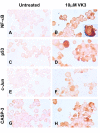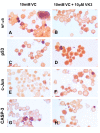Vitamin K3 and vitamin C alone or in combination induced apoptosis in leukemia cells by a similar oxidative stress signalling mechanism
- PMID: 21663679
- PMCID: PMC3127817
- DOI: 10.1186/1475-2867-11-19
Vitamin K3 and vitamin C alone or in combination induced apoptosis in leukemia cells by a similar oxidative stress signalling mechanism
Abstract
Background: Secondary therapy-related acute lymphoblastic leukemia might emerge following chemotherapy and/or radiotherapy for primary malignancies. Therefore, other alternatives should be pursued to treat leukemia.
Results: It is shown that vitamin K3- or vitamin C- induced apoptosis in leukemia cells by oxidative stress mechanism involving superoxide anion radical and hydrogen peroxide generation, activation of NF-κB, p53, c-Jun, protease caspase-3 activation and mitochondria depolarization leading to nuclei fragmentation. Cell death was more prominent when Jurkat and K562 cells are exposed to VC and VK3 in a ratio 1000:1 (10 mM: 10 μM) or 100:1 (300 μM: 3 μM), respectively.
Conclusion: We provide for the first time in vitro evidence supporting a causative role for oxidative stress in VK3- and VC-induced apoptosis in Jurkat and K562 cells in a domino-like mechanism. Altogether these data suggest that VK3 and VC should be useful in the treatment of leukemia.
Figures




References
-
- Gregory CD, Pound JD. Cell death in the neighbourhood: direct microenvironmental effects of apoptosis in normal and neoplastic tissues. J Pathol. 2011;223(2):177–194. - PubMed
-
- Baran I, Ganea C, Scordino A, Musumeci F, Barresi V, Tudisco S, Privitera S, Grasso R, Condorelli DF, Ursu I, Baran V, Katona E, Mocanu MM, Gulino M, Ungureanu R, Surcel M, Ursaciuc C. Effects of menadione, hydrogen peroxide, and quercetin on apoptosis and delayed luminescence of human leukemia Jurkat T-cells. Cell Biochem Biophys. 2010;58(3):169–179. doi: 10.1007/s12013-010-9104-1. - DOI - PubMed
-
- Lamson DW, Gu YH, Plaza SM, Brignall MS, Brinton CA, Sadlon AE. The vitamin C: vitamin K3 system - enhancers and inhibitors of the anticancer effect. Altern Med Rev. 2010;15(4):345–351. - PubMed
LinkOut - more resources
Full Text Sources
Research Materials
Miscellaneous

